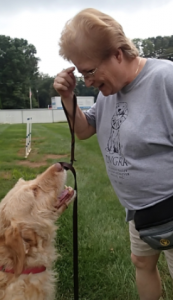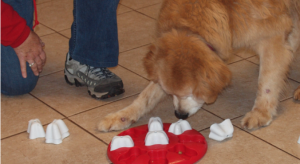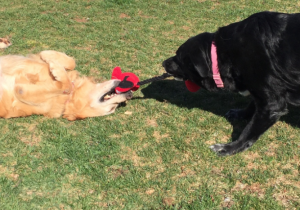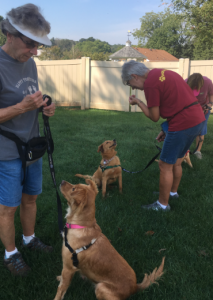 Teaching Eye Contact
Teaching Eye Contact
Shy dogs are often afraid to make eye contact because they may perceive it as a challenge or a threat. Staring down or constant eye contact with a scared dog can cause more fear. Teaching them to “watch me” will help build confidence and change what they perceive as a threat to trusting their person. It is useful in stressful situations when asking them to look at you. It will help calm your dog down and give them a chance to refocus on you.
Capture your dog’s attention with a tasty treat. Holding it between your fingers, raise the treat between your eyebrows while the dog is looking at it until your eyes meet. Say, “Watch me” and reward with a treat. Even a quick glance should be rewarded at first. Then work up to longer periods of more direct eye contact. When they do make eye contact, try not to have a hard stare; blink a little.
Once your dog is doing this reliably, you can raise your index finger (without a treat) between your eyes. Continue saying, “Watch me,” and rewarding with a treat. Eventually your dog will catch on to the words “watch me,” and you will be able to simply say the words without the hand gesture.
Learning this activity will help if you need to quickly capture your dog’s attention, whether to alert to an emergency or simply to get their attention.
![]()
Watching Television
Pictures moving on a television screen can be very frightening to a dog that is not accustomed to them. Your dog may be fearful of coming into the room while the television is on or bark at the television in fear. To help them gain comfort with the TV, begin introducing it with no volume, playing a picture only. Choose a channel and mute the volume. If the dog responds well to the moving pictures, very slowly turn up the volume to a soft level.
Repetition is often a good way for your dog to become more comfortable with unfamiliar things around the house. In this case, simply leave the TV on and act as if everything is fine and dandy. Once your dog realizes the moving pictures are not going to hurt them, they’ll become accustomed to them. This may take days or weeks, so be patient. You can help to make watching TV a positive experience by combining it with an activity your dog enjoys, such as eating a few favorite treats, being brushed or petted, or playing with a favorite toy.
![]()
 Choice and Control
Choice and Control
“The power to control one’s own outcomes is essential to behavioral health.” ~ Dr. Susan Friedman.
Dogs coming from puppy mills have never had any control over their environments. Many domestic dogs don’t have a huge amount of control either. We make most of their choices for them like what food and what time they eat and when they get to go outside. However, most pet dogs can choose things, like if they want to lie on the carpet in the family room or the tile in the hallway. They can choose if they want to chew on their bone or their squeaker toy. They have learned that if their owner asks them to sit and they do it, they will get a reward. Many probably have learned if they go to the cookie cabinet and give a sad, puppy-dog-eye look, they will get a cookie.
Puppy mill dogs have never had any control over their environment or any choice in where they sleep or what toy they play with, if they have even had anything to play with at all. Learning that they can control and manipulate their environment to get good things can go a long way toward building confidence. This is also the first step in training them. We use rewards to train them, and they need to learn that they can do something to get something good.
Food puzzles and food-dispensing toys are a great way to teach these dogs that they can control their environment to get good things. They learn if they spin the toy, they get food. There are dozens of food puzzles and food-dispensing toys on the market. For a skittish dog, some of the toys may be scary as they have moving parts and may make a little noise when they move. You can start with a simple piece of cardboard partially covering their food bowl. They have to move it to get to the food. Or put some treats into a toilet paper or paper towel roll. Gradually increase the difficulty.
![]()
 Playing with Toys
Playing with Toys
Sadly, many puppy mill breeder dogs or unsocialized dogs have never seen a dog toy before and literally have to “learn” how to play. Some dogs, once they get into a home, do not understand that chewing on shoes, wood trim, carpet, or dangerous things like wiring is inappropriate. They need encouragement and guidance to play with toys that are made for dogs. This can be difficult for a dog that has never before been free to play.
Obviously, there are many types of toys you can buy for your dog, including hard sterilized bones, tennis balls, stuffed toys, squeaker toys, etc. You’ll need to experiment to see what appeals most to your dog and what lasts the longest… or rather, is not chewed up or destuffed!
Some of the most successful toys we’ve used in PHL fall into the category of “interactive toys.” These are especially helpful with breeder dogs because they encourage the dog to exercise their brain as well as interact with humans. We recommend interactive toys that dispense food and treats. Be sure they are sturdy and do not have small pieces they can swallow. Interactive food puzzle toys should always be supervised when in use. You can look online for food puzzle toys such as the Kong® Wobbler. We also have some of these toys available in our store, Pap’s Place, at DVGRR or through our website. You can also create your own food puzzle games. Put treats in a muffin tin and cover the treats with a tennis ball. Put high-value treats under plastic cups for them to knock over. Be creative!
![]()
Building Confidence
Increasing confidence will help your dog approach new situations with ease and become less fearful of things that are out of the normal routine. This is a key element to help your dog progress successfully.
Walking on different surfaces is a good place to begin confidence building. Many mill dogs or kennel dogs have only walked on one surface – many have never felt grass beneath their paws or a soft comfy dog bed. At DVGRR, we expose the dogs to yards with stone, grass, and mulch. In our outdoor yards, we have stairs (made by Boy Scouts) to teach the dogs to walk up and down steps as well as to get comfortable with the texture of walking on decking material that many homes have. In the summer time, we have doggie pools for them to explore if they choose.
Indoors, we teach dogs to walk over bath mats, dog beds, etc., and we also use balance discs used in fitness classes for them to put their paws on. You could even try interlocking foam flooring squares or yoga mats. We have platforms and exercise steppers to teach them “paws up.” We do this by first placing treats on the platform or dog bed. Gradually, we use the treat to guide them over the bed or up onto the platform and reward. Be creative: Anything you can envision your dog to put their paws on or “target/touch” is great for building confidence. Eventually, your dog may be brave enough to try their paws on agility equipment!
![]()
 Basic Obedience
Basic Obedience
Before starting to “train” your fearful dog, you need to have gained some level of trust. (Really, every time we interact with our dogs, we are teaching them something.) Teaching them basic cues can really increase their confidence. But – and we cannot stress this enough – all training must be reward based with no coercion, punishments, or corrections. Failure to perform should be ignored and doing the task rewarded. For guidance on how to teach these skills, we have included a list of useful books at the end of “Continuing the Journey.” In addition to teaching your fearful dog obedience, teaching simple tricks can also build their confidence. We’ve also included a useful site on teaching tricks at the end in the Recommended Reading & Resources section.

